The best ski boots in 2024, tried and tested
Content is created by CNN Underscored’s team of editors who work independently from the CNN newsroom. When you buy through links on our site, CNN and its syndication partners may earn a commission. Learn more
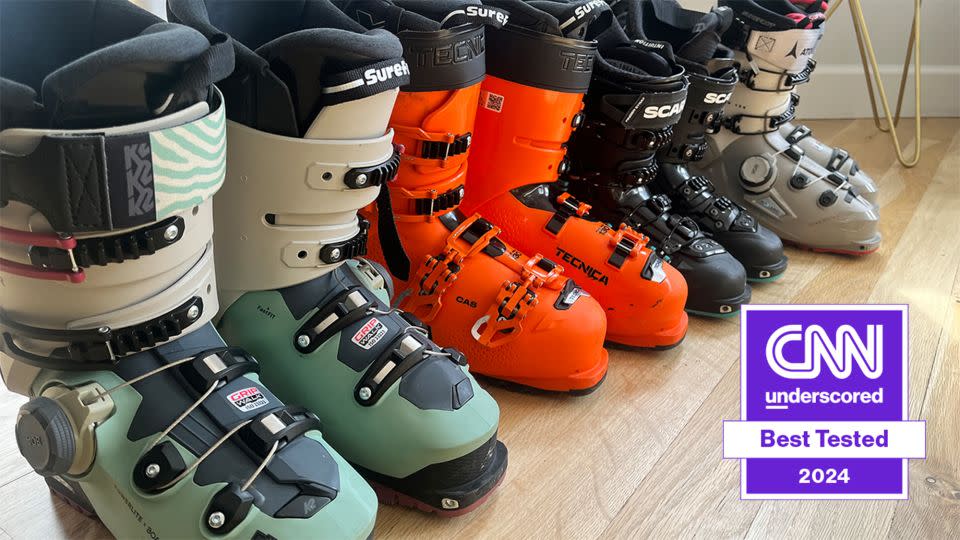
It doesn’t matter if you’re a hardcore skier with 100 days per year on the slopes or a beginner learning how to snowplow: ski boots are the most important piece of ski gear.
“We say date your skis but marry your boots,” says Austin Nelson, a 15-year boot fitter and manager at Surefoot, a ski boot store in Aspen, Colorado. “They are the connection between your body and your skis, allowing you to ski better and more comfortably.”
Not only do well-fitting boots feel better on the slopes, but they also help you shred harder by transferring energy to your skis. And these days, there are more options than ever with various fits, plenty of flex offerings, customizable liners and even new BOA enclosures. That’s why we spent the last two months testing 11 pairs of ski boots while scoring powder runs at Aspen Snowmass Ski Resort. With more than 50 days of combined testing, we compared their performance and fit, eventually arriving at the best downhill and hybrid ski boots. Here are the results.
Tecnica Mach1 MV 120
Best downhill ski boots
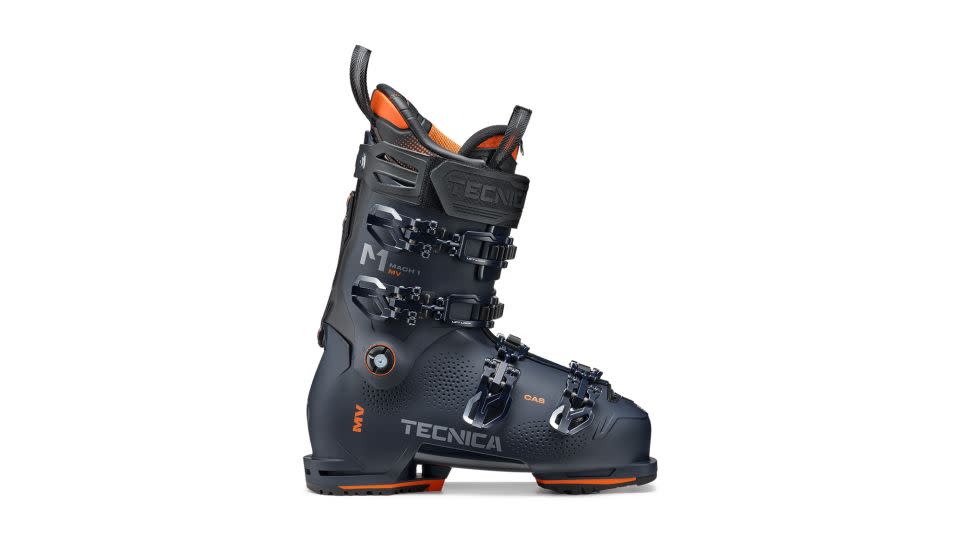
The Mach1 ski boots come with an anatomically shaped liner that’s comfy out of the box, and you can also choose from three foot shapes (LV, MV and HV). Combined with a powerful drive and (relative) warmth on cold days, these boots will perform well and fit great for the vast majority of skiers.
K2 Mindbender 120 BOA
Best hybrid ski boots
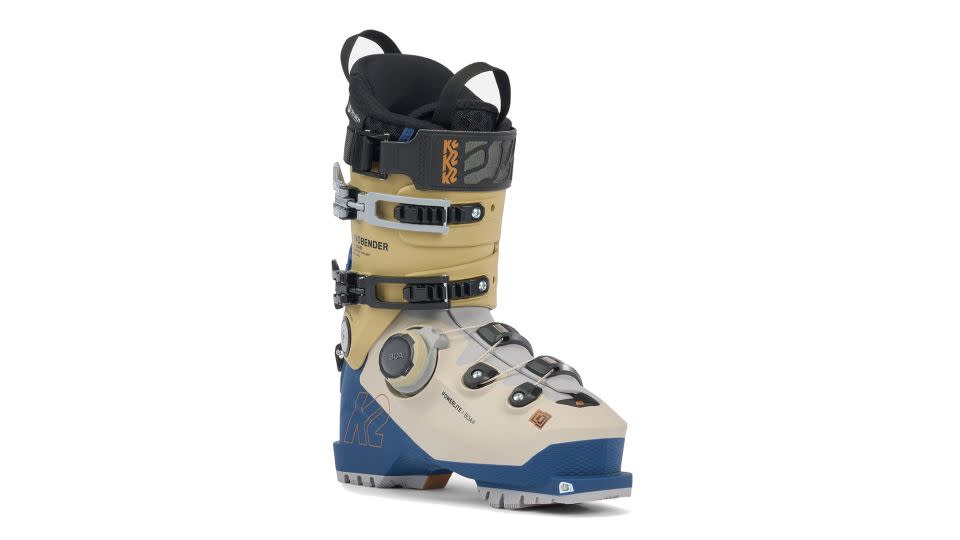
If you’re hankering for a one-boot quiver to ski the resort or tour the backcountry, the K2 Mindbender has you covered. The boots power through any terrain the ski hill throws your way, but they still have enough mobility to make an uphill walk downright comfortable. And, it uses the newly-launched BOA enclosure system for an even and secure fit.
$640 at K2 Snow
$560 at Cripple Creek Backcountry
Best downhill ski boots: Tecnica Mach1 MV 120
$700 at Blizzard Tecnica; $700 $560 at Evo and REI
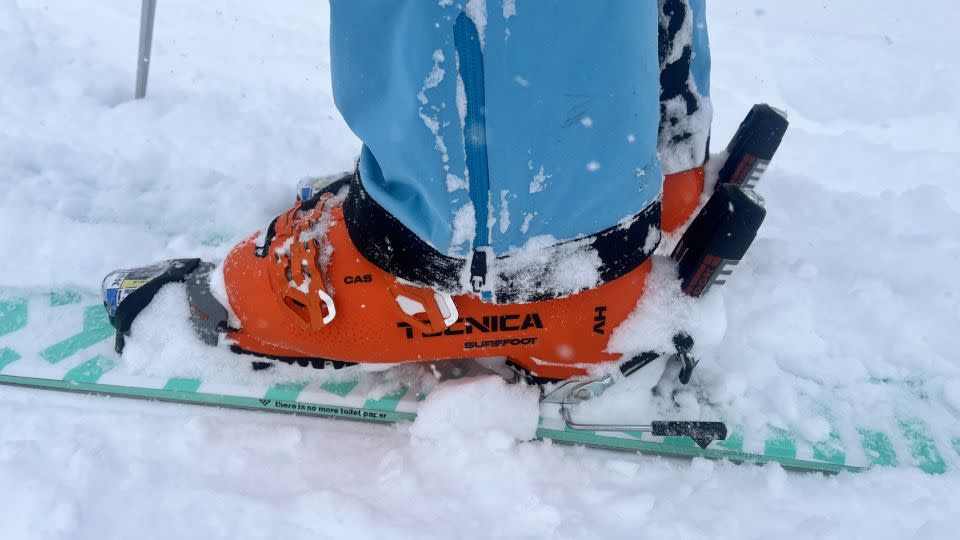
Ski boots aren’t known for comfort, so it’s a pleasant surprise when one fits nicely straight out of the box. That was our experience with the Mach1 ski boots, our top pick thanks to their unparalleled combination of coziness and bomber performance — even before we had anything customized.
First, you’ve got options. The Mach1 boot series is available in three different widths: LV (low volume), MV (mid volume) and HV (high volume), all designed to work with various foot shapes. The LV models have a narrower last (98 millimeters) while the HV boots (103 millimeters) are best for wider tootsies. Thanks to our hobbit-esque feet, we tested an HV model but also popped our feet into the MV boots (100 millimeters) to gauge the difference and found both to be incredibly comfortable.
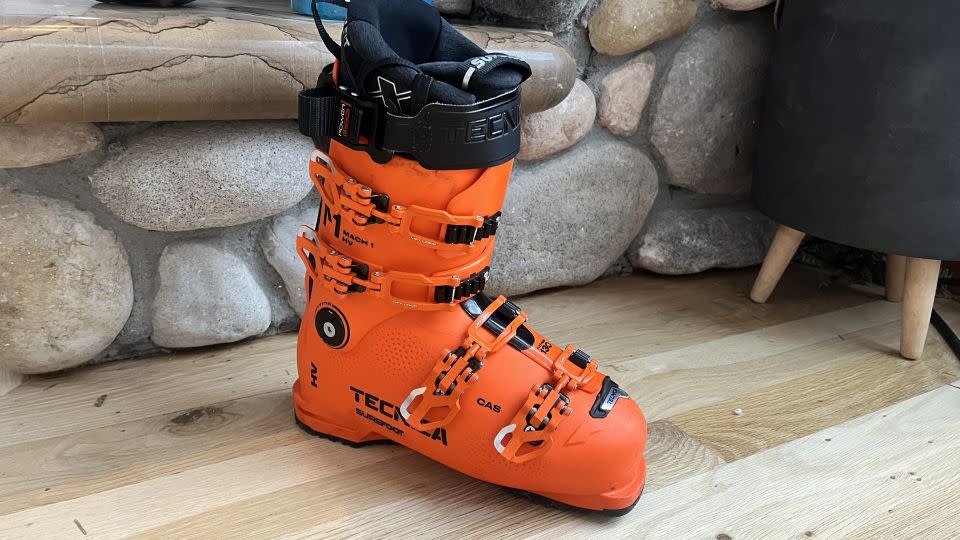
We also credit this to Tecnica’s anatomically shaped outer shell. There isn’t a skier alive who considers their clunky plastic boots to be plush and cozy, but the Mach1 shell gave us one of the best-in-test fits from day one. After a week of skiing, we took the boots to get fitted at Surefoot. Thanks to a customizable liner, shell, footbed and tongue, we dialed in the final details for a best-in-class fit — for a traditional buckle boot.
Tradeoff: The Mach1 boots don’t have the newly-launched BOA system found on many of the other boots we tested like the Salomon S/Pro Supra BOA or the Fischer RC4 MV 120. In our testing, we preferred the minuscule adjustments afforded by the dial system and found the BOA fit to be generally better. However, the Tecnica Mach1s still took the top spot thanks to their variety of available widths and overall fitting options (combined with their stellar performance, more on that below). But, we certainly wouldn’t be mad if they launched a new version next year with BOA.
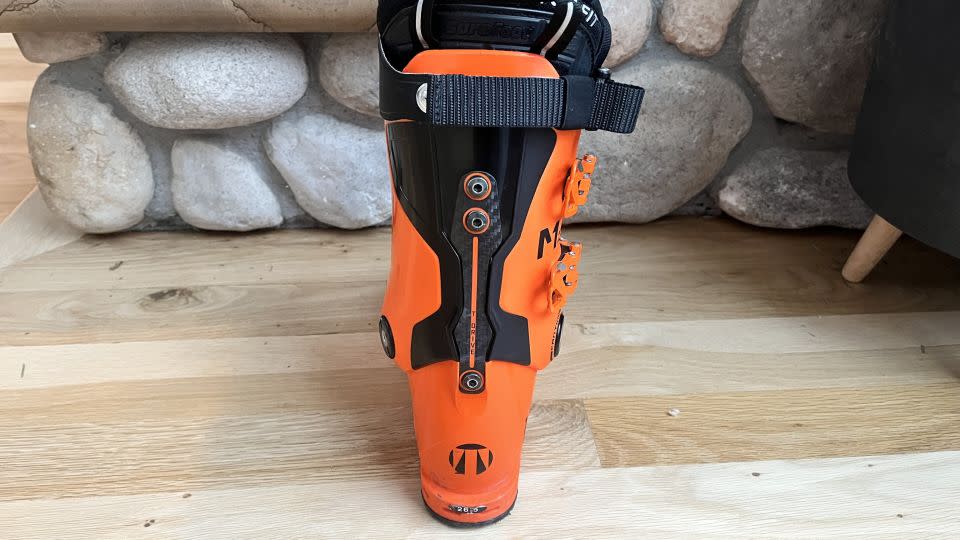
Fit is only half of the equation, and the Mach1 boots ski well, too. Tecnica uses a carbon spine that connects the cuff to the shell. Ski boots all have a flex, or stiffness, that transfers the energy from your legs to your skis, and this carbon spine helps regulate that flex so the boots are predictable and precise while shredding. In testing, this predictability coincided with a 42% increase in our balance while turning, as shown by our Carv data (more details in the “How we tested” section below). The Lange Shadow 130 LV was the only boot in our test that felt more precise in its performance but had a very different fit that was less versatile.
In addition to a 130 flex, the Tecnica Mach1 boots are also available in a 110 flex for smaller or less-experienced male skiers. For women, you can find them in a 95, 105 or 115 flex.
Ultimately, the Tecnica Mach1 MV 120 ski boots took our top spot for downhill ski boots because of their powerful performance on a variety of terrain combined with a crowd-pleasing fit that will work for a large number of intermediate and advanced skiers.
Best hybrid ski boots: K2 Mindbender 120 BOA
$800 at K2 and Cripple Creek Backcountry
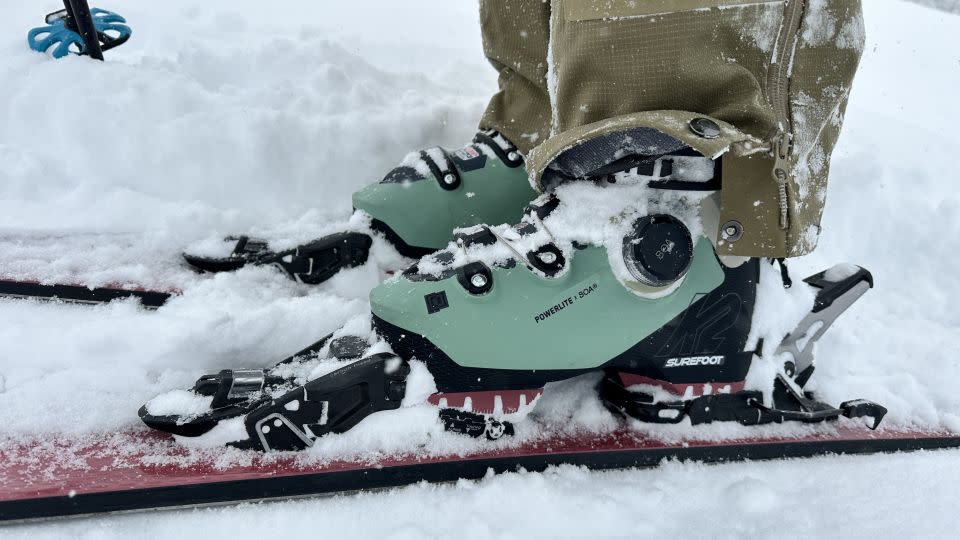
To many skiers, the prospect of a single-boot quiver is more elusive than Bigfoot. But the 2023-24 ski season brought to market many new hybrid ski boot options. Our favorite was the K2 Mindbender since it skis like a traditional downhill ski boot from a chairlift, but is still plenty comfortable when taking the occasional walk up a mountain.
Unlike downhill ski boots like the Tecnica Mach1, hybrid ski boots are designed with two goals in mind: They need to be stiff enough to shred on the downhill yet light and flexible enough to agreeably ski tour or uphill ski at a resort. This is where the phrase single-boot quiver comes into play — we want one ski boot to do it all. To that end, the Mindbender does a great job, particularly for skiers who emphasize downhill skiing.
While BOA enclosures have been successful in the snowboarding market for a while, this is the first year they’ve been used on ski boots. The Mindbenders have one dial that replaces the two lower buckles, and we really enjoyed the precise fit in testing. We found it to be much easier to dial in an even wrap around the top of our feet and never experienced any hot spots that have become the norm with traditional buckle boots. The dial is also easy to use while wearing mittens, so we could bend over mid-mountain to tweak our fit without removing any hand coverings (we also tested two other hybrid boots with this same BOA dial: Atomic Hawx Ultra XTD 130 BOA and Fischer Ranger 115 DYN). If we cinched the boot too tightly in testing, it was easy to turn the dial a tick or two backward to slightly loosen without having to readjust the whole thing.
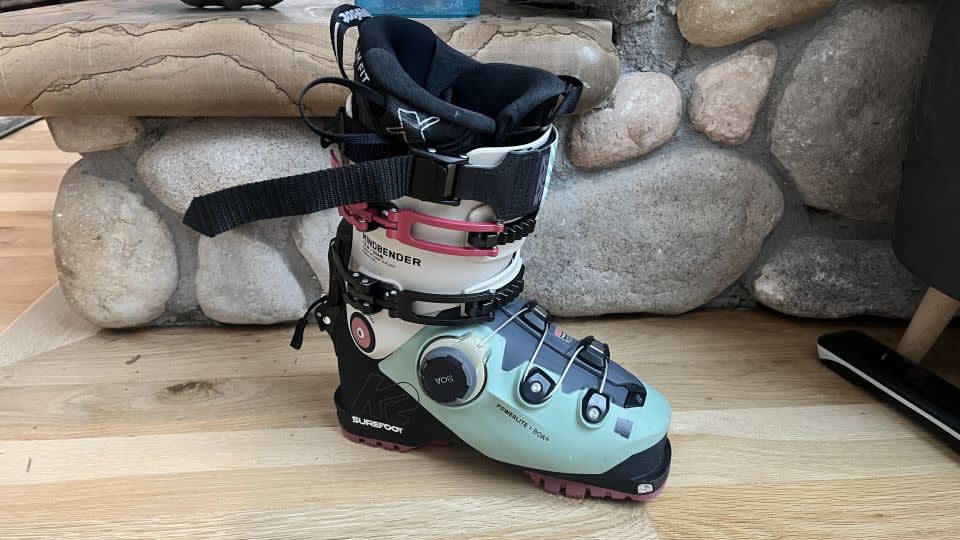
Unlike more performance-oriented boots like the Lange Shadow 130 LV or even the Rossignol Hi-Speed Elite 130 LV, the Mindbenders have a relaxed, higher-volume fit that will please intermediate to advanced skiers. But don’t fret if you have narrow feet. Thanks to the BOA dial on the bottom, it’s really easy to cinch down the bottom of the boot to get a snugger fit. And if a flex rating of 120 isn’t right for you, the K2 Mindbender BOA boots are also available in 95, 115, 120 and 130 options.
In downhill mode, the Mindbenders ski nearly as well as a traditional alpine boot — and they weigh nearly as much at over 4 pounds per boot. We skied the Mindbenders for six days of resort skiing and they handled choppy snow, powdery drifts and icy slabs just as well as the alpine boots in testing. We enjoyed skiing them before any customization, but we also found them to be especially powerful after the boot fitting at Surefoot.
The downhill prowess comes with a tradeoff: uphill performance. They’re the heaviest hybrid boot in our test, and we definitely felt the added ounces while slogging up 1,800 vertical feet at Aspen Snowmass Resort. K2 says the boots have 50 degrees of range of motion when in uphill mode, but they felt less mobile and a lot stiffer than that. The Mindbenders have GripWalk and an easy-to-reach (albeit huge) walk mode lever on the back of the boot.
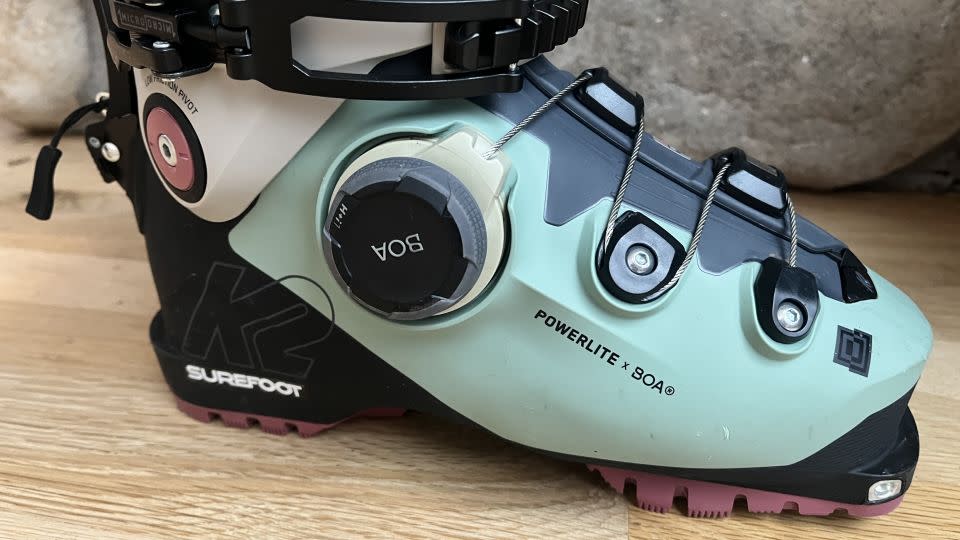
Still, skiers have to choose when it comes to hybrid boots: emphasize downhill performance or uphill performance. There is no single hybrid boot that will be the best of the best in both categories. The Mindbenders prioritize the descent. If you spend most of your time skiing from a chairlift and simply dabble in the backcountry a few times per year, these are a great bet.
If you are a backcountry skier who wants to go light-and-fast while ski touring and will only occasionally ski a lift-served lap, we’d recommend either the Atomic Hawx Ultra XTD 130 BOA or the Scarpa 4-Quattro XT. Both have excellent uphill performance and are great on the descents, but we wouldn’t reach for these during resort days.
Everything you need to know about ski boots
Skis have flashy designs but your ski boots are easily the most important piece of gear in your kit. “With a well-fitting boot, the transfer of energy from your body to your ski is more efficient,” says Nelson. “For beginners, a well-fitting boot allows you to progress much faster because you have better control and use less energy, making skiing easier.”
But, ski boots are also confusing and most skiers are actually wearing the wrong size. That’s why it’s helpful to understand ski boot construction — and see a boot fitter before making any big purchases.
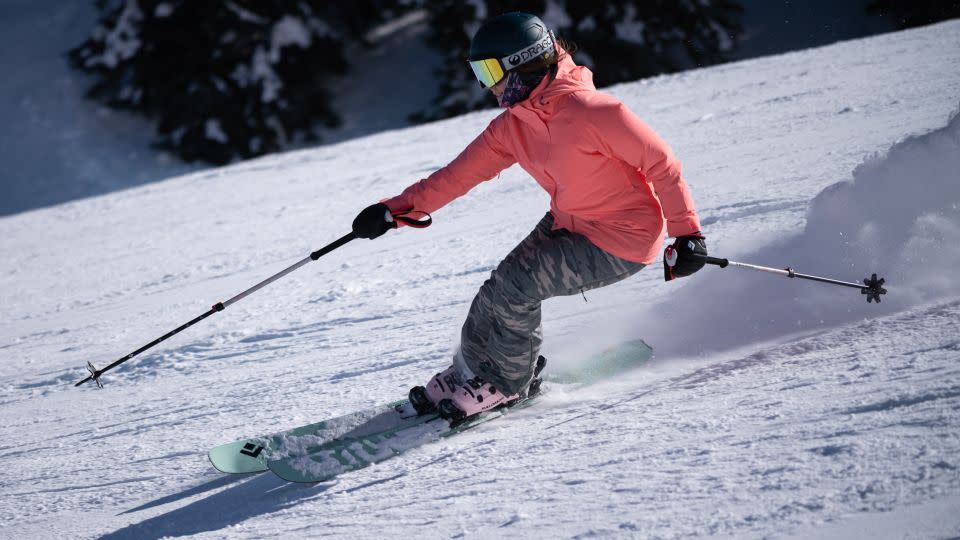
First, it’s important to understand the difference between a downhill, a touring and a hybrid ski boot. Alpine (or downhill) ski boots are the traditional ski boots seen all over a ski resort, and they click into bindings with a toe and heel piece that are held onto the skis with bindings. These ski boots are the heaviest and the most rugged, and they are designed only for chairlift skiing. A touring (or backcountry) ski boot is much lighter and has more flexibility in the cuff so you can comfortably walk uphill while wearing your boots. Touring boots typically work with tech, or pin, bindings, so you’ll see small holes on either side of the toe piece and in the heel. Touring boots are not compatible with traditional downhill ski bindings and they are often too light to be fully enjoyable while skiing at the resort. That’s where hybrid boots come into play, as they aim to split the difference between alpine and touring ski boots. They’re usually heavier than touring boots but have more flexibility and comfort for climbing than alpine. And, they often work with both downhill and tech bindings. In this test, we only looked at alpine and hybrid ski boots.
Next, consider fit. According to Nelson, alpine ski boots should feel snug and support your feet without any movement around the ankles, heel and forefoot. “When you’re trying them on, bend your knees and flex forward,” he says. “If there is any movement at all or you can’t feel the front of your boots with your toes, they’re too big.” He also notes that a good rule of thumb is to go down a size in your ski boot when looking at the sizing charts.
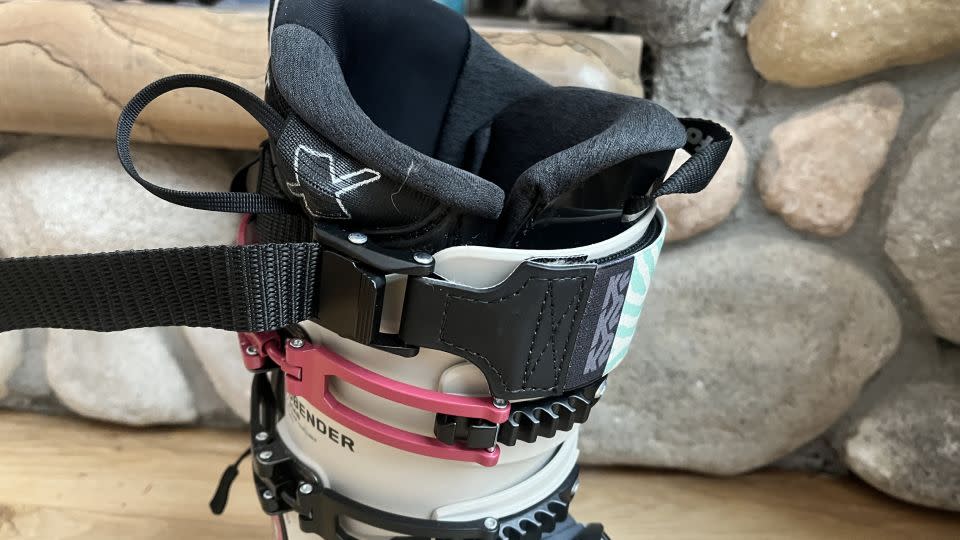
Of course, ski boot sizing doesn’t operate like street shoes. Instead, you’ll often see ski boots use Mondo (or Mondopoint) sizing. This is the length of your foot measured in centimeters. And while you may see Mondo sizes like 24.0 or 24.5 that appear to be half sizes, don’t be fooled — ski boot shells only come in whole sizes, so a 24.5 ski boot shell is the exact same size as a 24.0 ski boot (caveat: A few boot brands like Scarpa round up on the half size, so a 24.5 shell is the same size as a 25.0 shell. Again, another reason to see a boot fitter). Some ski boot brands will make the liner slightly smaller or bigger to more closely resemble a half-size, but the shell will still be the same. It’s also important to note your Boot Sole Length, or BSL number. Measured in millimeters, this is the length of your ski boot from the tip of the toe to the end of the heel. Since Mondo sizing can vary between brands, BSL is a more precise measurement of your size (and it’s also what they’ll ask when getting your boots fitted to your bindings).
Your last is the other factor to consider for fit. This is the measurement of your footbed width, so it dramatically varies from skier to skier. Narrow lasts typically range from 96 to 98 millimeters while average lasts are roughly 99 to 102 millimeters. Many boots, such as the Tecnica Mach1 or the Lange Shadow, come in a variety of lasts to accommodate more feet.
Beyond fit, take a look at flex. Most boots are available in a variety of flexes, ranging from softer to stiffer. Lower numbers are softer and are more comfortable, but are less responsive. Boots with a higher flex are stiffer and less cozy but respond better and transfer energy to your skis more efficiently. Typically, lower flex numbers are correlated with beginner skiers and higher flex numbers are better for experienced skiers. However, body weight and size are other factors as larger bodies can drive a stiffer boot better than smaller bodies. In general, beginners often prefer a flex in the 70 to 90 range, intermediate skiers may like a flex of 90 to 110 and experienced skiers may opt for a flex of 115 or higher. And as Nelson notes, some boots — like the Head Formula 95 W — have a bolt that can adjust the flex.
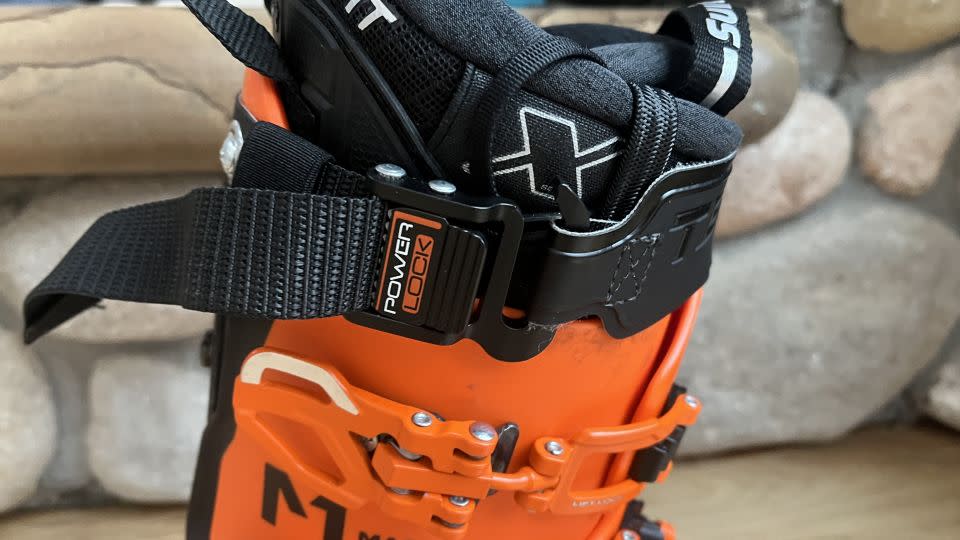
Take a glance at your boot sole to make sure it’s compatible with your bindings. These days, many new boots have GripWalk, a rubbered-and-rockered sole technology that makes it easier to walk around in alpine boots. If you have very old bindings, this technology may not be compatible, so check with your boot fitter or local ski shop.
Liners are another critical component of ski boots. Often filled with foam, this is the removable interior piece that sits inside the hard plastic shell. Some liners are plush and soft; these are designed for beginners who are less concerned about performance. Intermediate and advanced skiers often prefer a firmer foam since it molds to your feet and offers better performance. Many boots come with heat-moldable liners that can be taken to a boot fitter to fit your specific feet. For folks who spend a lot of time in ski boots or are ready to invest in a top-tier fit, boot fitters like Surefoot offer fully custom liners that are built from the ground up to accommodate your specific foot anatomy.
Lastly, look at the buckles on your boots. Historically, alpine ski boots use aluminum buckles to secure a snug fit: two on the upper boot and two on the lower. However, the 2023-24 season saw BOA enter the ski boot world by swapping the lower two buckles with a BOA cable enclosure. In addition to the K2 Mindbenders, we also tested a handful of other boots with BOA like the Salomon S/Pro Supra BOA, Fischer RC4 MV BOA, K2 Anthem 115 BOA and the Fischer Ranger 115 DYN. We strongly preferred the BOA fit in testing thanks to its evenly dispersed pressure and overall secure fit — both data points confirmed in this peer-reviewed study that took a look at BOA in ski boots. And Nelson notes that some skiers with limited dexterity may also prefer BOA to buckles. But, he also adds that skiers have fit preferences — like one loose buckle and one tight buckle — that BOA can’t accommodate.
How we tested
To determine the best ski boots, we objectively evaluated many factors like comfort, performance, durability and temperature performance. To do this, we divided our testing into five categories: comfort, ski performance, durability, features and temperature regulation. From there, we directly compared the features of each pair of ski boots through nearly two months of field testing while skiing at Aspen Snowmass Ski Resort. Here’s the breakdown of our process.
Comfort
Width and volume: Who would this boot be better for? Does it work for a variety of people before and/or after boot fitting?
Cuff and heel rise: How does the overall pressure feel against your foot? Is there too much heel rise?
Overall feel: As a score of 1-10, how does the foot feel before fitting? How does it feel after?
Performance
Flex: How does it feel? Is it even? Too firm or too soft?
Responsiveness: How does it move through a variety of terrain? Can it handle bumps, steeps, jumps, etc?
Fitting: Compare the performance before and after boot fitting. How does it stack up against the other boots?
Durability
General thoughts: In the limited testing window of eight weeks, did anything break or prematurely malfunction?
Features
BOA: If it was used, how did it feel? Did it perform as well as the buckle boots?
Boot sole: Does it have GripWalk?
Hybrid boots: How easy is the walk mode lever to use? Does it inadvertently move on its own?
Power strap design: How easy is it to use? Does it affect the use of other devices like Carv or heated boot liners?
Temperature Regulation
Boot entry: On the coldest days, can you slide your feet into the boots or is it nearly impossible?
Warmth: Do the boots retain any warmth while skiing?
We also aimed to find a standardized set of data to use in our testing so that we weren’t completely reliant upon subjective tester feedback. To do this, we enlisted the help of Carv, a digital ski coach that gathers data from inside your ski boots. According to Carv, some of the product’s measured data points like stability and pressure, edging and balance can also be a reflection of the ski boot. Knowing this, we gathered this data while testing the ski boots, ensuring that the same skier skied the same run in the same ski while wearing different ski boots. As a result, the boot was the only measured variable that changed.
Through its app, Carv will create growth graphs for skiers, so we were able to chart our growth in various areas based on when we started using a ski boot and when we stopped. For example, if we tested a more responsive boot, we might see an uptick in our scores for stability, pressure and balance. We didn’t base our feedback entirely on the Carv data because it’s inconclusive as to how much of this performance growth ties to the boot and how much ties to the skier. However, we first looked at anecdotal testing feedback to get a pulse on the ski boots. Then, we looked at the data to see if it showed what we felt during field testing.
We also used Carv to obtain data pre and post-bootfitting. All ski boots were tested out of the box for at least a week, obtaining baseline data with Carv. Then, we took them to Surefoot for a boot fitting to learn how the boots’ performance may or may not change when properly fitted.
Other ski boots we tested
Atomic Hawx Ultra XTD 130 BOA
$950 Evo or Cripple Creek Backcountry
We came within a millimeter of awarding the Hawx the best hybrid ski boot in our test; it’s a fantastic boot. We loved the use of BOA and found it to be exceptionally strong on the uphill. While it comes stock with a narrow design best suited for low-volume feet, the team at Surefoot told us it can be easily customized to pretty much any foot shape, making it a great boot for a large number of folks (as our wide-footed tester learned when these became his favorite). The K2 Mindbenders edged it out for the top spot simply because they are better on the downhill at a lower price point, which is a priority for our audience. But if you want a boot that excels in the backcountry (and have the money for a custom fitting if you have wide feet), the Hawx is a great choice.
Salomon S/Pro Supra BOA 105
$700 at Salomon or Evo
This Supra BOA was one of the more comfortable downhill boots we tested this year, second only to the Head Formulas. We found the 105 flex to be a sure bet for solid intermediate to advanced female skiers. A nicety was the numerical marking on the lower boot so you could adjust the BOA system to the same point every time you ski. The cushioned liner was cozy but not plush and there is plenty of space inside for higher-volume feet. However, we felt the overall comfort came with less responsiveness than the Tecnica Mach1 boots. Also available in a 120 flex.
Fischer RC4 120 MV BOA
$750 at Fischer or $600 at Evo
Similar to the Salomon boots, the Fischer RC4s are another offering with BOA and built with comfort in mind. The MV fit is a slightly wider last that works for average feet, but we felt that it had a bit more wiggle room than the MV fit on the Tecnica Mach1 boots. However, we struggled with ankle fit and could never quite find a sweet spot that didn’t irritate our skin. The BOA enclosure did not have any marking points so we weren’t ever sure if we were cinching it down to the same spot — this could be the cause for the hot spots. Also available in a 130 or 105 flex.
K2 Anthem 115 BOA
$800 at K2 or Evo
This women-specific boot will probably fit a lot of female skiers — just like K2 designed it. The pre-punched ankle bone areas were a nice touch that felt good on our feet immediately (which was noteworthy, as those bones are especially finicky in ski boots). The 115 progressive flex felt fun and powerful, especially while carving turns on groomers or bouncing through mogul fields. The tradeoff, however, is the roomy fit. K2 designed these with a multi-fit last, meaning you can cinch down the BOA to fit anyone with narrow to wide feet. But it still felt a bit spacious and too comfortable, often sacrificing precision in tight spots. Also available in a 105 and 95 flex
Lange Shadow 130
$1,000 at Lange or $850 at Evo
In terms of performance, you’ll be hard-pressed to do better than the Lange Shadows. They’re powerful on any terrain thanks to a unique dual-pivot technology that allows skiers to drive harder without expending more energy — and it was noticeable in testing as we arced turns and bombed steeps without breaking much of a sweat. But the boot isn’t designed for recreational skiers; it’s a performance fit for advanced shredders who care more about carving than comfort (and don’t mind spending extra cash). For recreational skiers, the Shadow is overkill. Also available in flexes ranging from 85 to 120.
Scarpa 4-Quattro XT
$870 at Scarpa or Cripple Creek Backcountry
At just over three pounds per boot, the 4-Quattro XT is a killer hybrid boot. With an advertised 61 degrees of ankle mobility, this featherweight felt amazing while climbing over 3,000 vertical feet near Aspen. The four cabled buckles are easy to use and the power strap adds a bit more stiffness to the 115 flex on the downhill. The Quattros can be used with tech or GripWalk alpine bindings, and we had no problem clicking into our Marker Griffon bindings. On the downhill, they skied well on groomers and through the trees, but they didn’t have the powerful performance of the K2 Mindbenders. Still, if you’re a skier who more evenly splits your time between ski resorts and the backcountry, the Quattros are a great bet. Also available in a 130, 120 or 100 flex.
Head Formula 95 W MV
$600 at Glacier Ski Shops or Christy Sports
With a middle-of-the-road 100-millimeter last and an extended toe box, the Formulas took the top spot as the most comfortable boot we tested (the furry cuff didn’t hurt, either). The 95 flex can be adjusted up to 105 with a specialized bolt, so it’s a softer boot meant for beginner to intermediate skiers — and that’s how it skied, too. The ankles had a bit more wiggle room than the Tecnica Mach1 which helped with comfort, but also felt sloppy as terrain became more challenging. Also available in low volume (LV) designs with an 85 and 105 flex for women, as well as a 110, 120 and 130 flex for men.
Rossignol Hi-Speed Elite 130 Carbon LV GW
$850 at Rossignol or Christy Sports
Similar to the Lange Shadows, the Rossignol Hi-Speed Elite boots are built for hard-charging skiers who go full-send, no matter the day. Like other boots we tested, they have a progressive flex that gets stiffer as you flex deeper, but they felt firmer than the Shadows (the other 130 flex we tested). They definitely have a low-volume fit and we had a nagging pain in the arch that we couldn’t eliminate until we went to Surefoot. Ultimately, they could be a great boot if you’re an advanced skier, but they are more boot (and money) than the average weekend warrior will need.
Note: The prices above reflect the retailers' listed price at the time of publication.
For more CNN news and newsletters create an account at CNN.com

